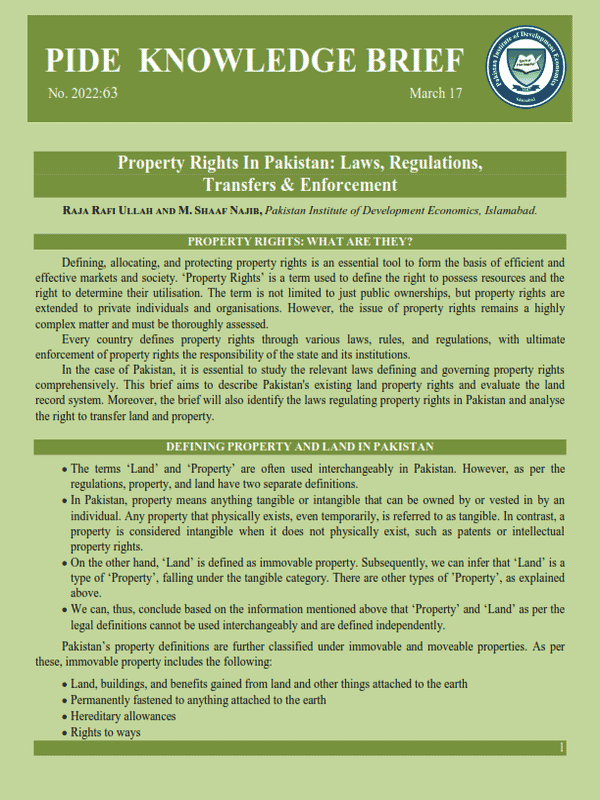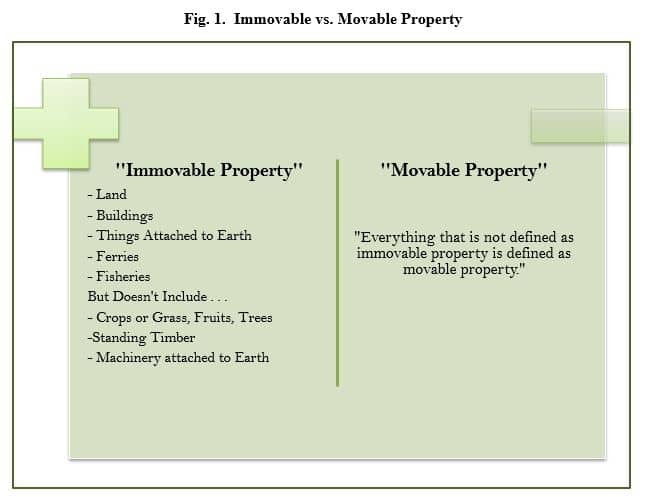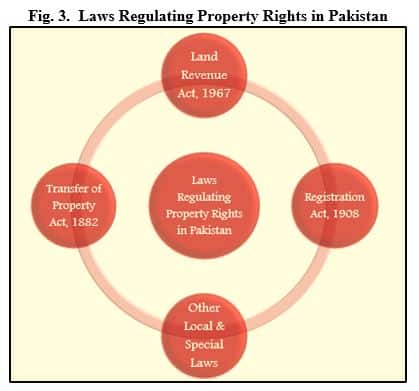
Pakistan Institute of Development Economics
- Home
Our Portals
MenuMenuMenuMenuMenuMenuMenu - ResearchMenuMenuMenuMenuMenuMenuMenu
- Discourse
- The PDR
- Our Researchers
- Academics
- Degree Verification
- Thesis Portal
- Our Portals
Property Rights In Pakistan: Laws, Regulations, Transfers & Enforcement
Property Rights In Pakistan: Laws, Regulations, Transfers & Enforcement
Raja Rafi Ullah and M. Shaaf Najib, Pakistan Institute of Development Economics, Islamabad.
PROPERTY RIGHTS: WHAT ARE THEY?
Defining, allocating, and protecting property rights is an essential tool to form the basis of efficient and effective markets and society. ‘Property Rights’ is a term used to define the right to possess resources and the right to determine their utilisation. The term is not limited to just public ownerships, but property rights are extended to private individuals and organisations. However, the issue of property rights remains a highly complex matter and must be thoroughly assessed.
Every country defines property rights through various laws, rules, and regulations, with ultimate enforcement of property rights the responsibility of the state and its institutions.
In the case of Pakistan, it is essential to study the relevant laws defining and governing property rights comprehensively. This brief aims to describe Pakistan’s existing land property rights and evaluate the land record system. Moreover, the brief will also identify the laws regulating property rights in Pakistan and analyse the right to transfer land and property.
DEFINING PROPERTY AND LAND IN PAKISTAN
- The terms ‘Land’ and ‘Property’ are often used interchangeably in Pakistan. However, as per the regulations, property, and land have two separate definitions.
- In Pakistan, property means anything tangible or intangible that can be owned by or vested in by an individual. Any property that physically exists, even temporarily, is referred to as tangible. In contrast, a property is considered intangible when it does not physically exist, such as patents or intellectual property rights.
- On the other hand, ‘Land’ is defined as immovable property. Subsequently, we can infer that ‘Land’ is a type of ‘Property’, falling under the tangible category. There are other types of ’Property’, as explained above.
- We can, thus, conclude based on the information mentioned above that ‘Property’ and ‘Land’ as per the legal definitions cannot be used interchangeably and are defined independently.
Pakistan’s property definitions are further classified under immovable and moveable properties. As per these, immovable property includes the following:
- Land, buildings, and benefits gained from land and other things attached to the earth
- Permanently fastened to anything attached to the earth
- Hereditary allowances
- Rights to ways
- Lights
- Ferries
- Fisheries
The following, however, are not to be considered as immovable property:
- Standing timber
- Growing crops or grass
- Fruit upon and juice in trees regardless of whether it exists presently or currently is just expected to grow in future
- Machinery embedded in the earth, particularly in cases where it is dealt with apart from the land.
The above are thus considered under ‘Moveable Property’. This is because of the definition of ‘Moveable Property’, explained in reference to immovable properties. In summation, all property that cannot be defined as immovable property shall be considered ‘Moveable Property’.
LAND OWNERSHIP: WHO IS ALLOWED?
The property rights are defined and protected under the Constitution of Pakistan through various laws and rules and regulations. Special and specific laws are in place to define and protect different types of property rights.
Four articles of the Constitution of Pakistan deal with private property rights in the country. These include Articles[1] 23, 24, 172, and 173.
Regulation and Administration of Property Rights with Special Reference to Land Records
The system of land records and enforcement of property rights system in Pakistan are closely tied to the ‘Revenue Collection’ system. Since colonial times, revenue departments have done law enforcement of property rights and recording and maintenance of land. The respective revenue departments of provinces are in charge of land administration and enforcement of property rights.[2]
These provincial revenue departments are ‘with which every person has to come in contact concerning any matter in relation to or arising out of land’.[3] However, the system is devolved so that immediate maintenance of and hence any changes in land records happens at the sub-district level, i.e., the Village and Tehsil levels.[4] The figure above depicts the formal levels characteristic of this devolution (See Figure 2).
 ___________________________
___________________________
[1] Constitution of Pakistan
Article 23: ‘Every citizen shall have the right to acquire, hold and dispose of property in any part of Pakistan, subject to the Constitution and any reasonable restrictions imposed by law in the public interest’.
Article 24: ‘No property shall be compulsorily acquired or taken possession of save for a public purpose, and save by the authority of law which provides for compensation therefore and either fixes the amount of compensation or specifies the principles on and the manner in which compensation is to be determined and given’.
Article 172: ‘Any property, which has no rightful owner shall, if located in a province, vest in the Government of that province and in every other case, in the Federal Government’. It simply means that if either the federal or the Provincial Government does not own a property, then private individuals shall own it.
Article 173 establishes Federal and Provincial Governments’ rights to purchase or acquire any property that shall vest in the Federal or concerned Provincial Government
[2] A GUIDE ON LAND AND PROPERTY RIGHTS IN PAKISTAN (2012) pg. 15
[3] Ibid.
[4] The basic unit for revenue administration and land administration is village/mauza. ‘Patwari’ is the most junior official within the revenue cadre but performs the important role of maintenance of land record registers. However, for administrative convenience, it is at the Tehsil level that these records are verified. The revenue officer at the Tehsil level called the ‘Tehsildar’ directly supervises all ‘patwaris’ in his/her tehsil. The ‘Tehsildar’ office is also in charge of making sure that all records made by ‘patwaris’ are correct and updated. Furthermore, the ‘Tehsildar’ office is also responsible for sanctioning of sale, purchase and mutation of land.
This land record keeping and administration system has been in practice since the middle of the 18th Century. The most easily traceable modern law that this system emanates from is the Law Revenue Act, 1967. All provinces and regions in Pakistan have adopted this law with minor changes and made relevant revenue and administration rules.[5]
LAND RECORD
Land records are the backbone of property rights enforcement. If no mechanism of maintaining land records exists, enforcement of property rights is impossible. Land records are essential not only for tracking and recording land ownership but also for revenue collection.
| BOX 1: Settlement Operation Settlement Operations are being carried out since the mid-18th century for the purpose of Land Record maintenance. It is a vast operation conducted under the supervision of Revenue Department and led by the Settlement Officer. Settlement Officers during the Settlement Operations are extended the powers of Collector, which normally is the power of Revenue Deputy Commissioner. The operation has two main objectives: 1. Conducting survey of the district to measure and map the land of every village. 2. To ascertain the value of total revenue due from a district before apportioning of the revenue among the land holders. |
An efficient Land Record System must have some essential characteristics:
- It should maintain the record of measurement, identification, partition, and delineation of the landholding.
- It should be able to identify and differentiate between cultivable and non-cultivable land.
- Village common land used for the collective purpose such as graveyards, grazing lands, community buildings etc., must be properly identified.
- Land ownership and transfer of ownership data must be efficiently maintained.
In Pakistan, to update the ‘Record of Rights’, a comprehensive Settlement Operation is conducted every 25 years. Following the Settlement Operation, Jamabandi is conducted every four years to prepare a Register of Mutations, commonly known as ‘Intaqalat’.
Land revenue remains one of the significant sources for tax collection, and hence there is a well-established system of land value assessment. Upon completion, the land records are handed over to the District Collector, and the team moves on to the next district. The downside to the settlement operation is that it is highly time-consuming, taking three to four years on average to conduct the operation in just one district.
_____________________
[5] A GUIDE ON LAND AND PROPERTY RIGHTS IN PAKISTAN (2012)
Laws Regulating Property Rights in Pakistan
The laws that regulate property rights in Pakistan and are relevant to our research questions are summarised in the section below.
- (i) Land Revenue Act, 1967[6] – Each province has its own set of laws that emanate from the Land Revenue Act, 1967. This is the basic law that deals with the records of rights and transfers through mutations. Each of the provinces has adopted this law, albeit with minor changes.
- (ii) Transfer of Property Act, 1882[7] – The general law describing and regulating matters of property transfer (lease, sale, mortgage, etc.) is the Transfer of Property Act, 1882.
- (iii) Registration Act, 1908[8] – The general law that regulates the registration of documents is the Registration Act, 1908. This law is applicable in our context, as whenever property rights are transferred or mutated, often requisite documentation needs to be registered(particularly in urban areas).
- (iv) Local and Special Laws – These local and special laws include laws governing housing societies whether they fall under the private category, cooperative societies, mutual societies, and cantonment boards, etc.
Some of the above-mentioned laws are more relevant in a rural context, whereas others are more applicable in urban areas. Some laws have ‘overlapping applications’ but on a general and practical levels, laws governing immovable property in rural areas are different from the urban areas’ immoveable property laws.[9] As we move forward and discuss the processes involved, this difference will become more apparent.
_______________________
[6] West Pakistan Land Revenue Act, 1967
[7] Transfer of Property Act, 1882
[8] The Registration Act, 1908
[9] A GUIDE ON LAND AND PROPERTY RIGHTS IN PAKISTAN (2012), UN-Habitat, pg. 7
How are Property Rights Transferred in Pakistan?
The fundamental law regulating property transfer in Pakistan is the Transfer of Property Act, 1882. This law, along with Land Revenue Act, 1967 and Registration Act, 1908, regulates the transfer of immovable property (land) in Pakistan. The processes and steps involved in transferring property differ depending on whether the land to be transferred is ‘rural’ or ‘urban’.
The following sections outline the steps involved in each of the two cases.
| BOX 2: Transfer of Property Rights in Rural Areas Note: The basic law that regulates transfer of immovable property/land in rural agriculture areas is the Land Revenue Act, 1967, its respective provincial versions and land rules enacted using the aforementioned act from time to time. Furthermore, the Transfer of Property Act, 1882 supplements the aforementioned law particularly with reference to defining ‘property’, ‘transfer’ and relevant limits and conditions. Step 1 – Any sane person or a minor (through their legal guardian) can report to the Patwari their intention to transfer their property rights. (sale, mortgage, gift or otherwise) If such a transfer has already taken place and the owner has died, then the report to patwari has to be made within three months. Step 2 – Upon being notified, the patwari is supposed to enter and record the intention to transfer rights in his/her daily register, and provide a free of charge copy of the entries in their daily register to the person reporting the event. Furthermore, the patwari is supposed to inform the concerned union council for public display of what has been reported to him/her. The patwari then has the responsibility to take the case higher up the revenue ladder (tehsildar office), so that entries are changed in the mutations register. Step 3 – A revenue officer in the concerned office of tehsildar (normally tehsildar or naib-tehsildar) is supposed to check, verify and then either accept or reject the transfer. Tehsildar has the power to reject any transfer expect those that involve cases of inheritance, are done through a registered deed or have been decreed by a court of law. Step 4 – The revenue officer from the office of tehsildar is supposed to note the precise description of rights that are being transferred, get signature of the person whose rights are being acquired, and make sure that the person is correctly identified by two persons, usually village headmen or members of the concerned union council. Step 5 – Ideally such a proposed transfer is to be verified through an open assembly of landlords from the area before records are changed in the mutations register. Step 6 – Typically it is not obligatory in rural areas to register the transfer of property separately. But in some cases it may be require or advisable to register this transfer under the Registration Act, 1908. |
| BOX 3: Transfer of Property Rights in Urban Areas Note: The basic laws regulating transfer of property in urban areas include Land Revenue Act, 1967, Transfer of Property Act, 1882 and Registration Act, 1908. All transfers of immovable property in urban areas are required to be registered under the Registration Act, 1908. This registration is necessary for official property records and tax purposes. This registration is done with the concerned sub-registrar which is normally the tehsildar office. Once the registration is made, then the office of tehsildar makes the mutation in the revenue records. The most common mode of transfer of immovable property in urban areas is through sale/purchase. The processes involved in this are summarised below: Process 1 – Obtain ‘Fard’ for proof of ownership from relevant office within the revenue department, if one is not in possession already. Process 2 – Use the appropriate stamp paper to draft the sale deed/contract. Usually experienced deed writers and/or lawyers are hired for this purpose. Process 3 – Payment of relevant stamp duty fees, capital gains tax and other related fees Process 4 – Registration of the sale deed with the relevant sub-registrar in whose jurisdiction the property is located. Process 5 – Eventual mutation in the sub-registrar office in the revenue record. Note: A significant percentage of total land in urban areas in Pakistan is covered by private housing societies, cooperatives and cantonments. For transfer of land (including sale/purchase) in these areas, involved parties don’t necessarily follow the processes mentioned above. This is because most of the time, the housing society or cooperative owns all of its land in the official revenue records. The owners of land and other immovable property are given ‘allotment letters’ which serve the purpose of proof of ownership/possession. These allotment letters are used when properties are being transferred. Sale deeds are drafted and signed by involved parties on stamp papers, but the entire transaction can be completed in coordination with the relevant housing authority’s office without the need to go the sub-registrar office or any office of the provincial revenue system. |
PROPOSED AND ONGOING REFORMS TO THE LAND RECORD & MANAGEMENT SYSTEM
In recent years, there has been a push across all provinces and federal territories to digitise all the land records and create more efficient management and transfer systems through the aid of technology. Some provinces are ahead of others in this regard regarding digitising technology to aid record-keeping and management of records and transfers. For instance, an efficient system is being implemented under Punjab’s provisions of the Punjab Land Record Authority Act, 2017. ‘Arazi Record Centers’ are being set up in each tehsil that shall have digitised records of all land ownership. The processes in areas where these centers are already operational might be slightly different from what is described above in this brief. However, despite this digitisation, the old system used for record-keeping and maintenance of records as described in this brief is still runs in parallel. It often takes precedence in case of any discrepancy.
REFERENCES
Punjab Land Record Authority Act, 2017.
The Constitution of Islamic Republic of Pakistan.
The Registration Act, 1908.
Transfer of Property Act, 1882.
UN Habitat, 2012. A GUIDE ON LAND AND PROPERTY RIGHTS IN PAKISTAN. Available at: http:// unhabitat.org.pk/wp-content/uploads/2021/07/A-Guide-on-Land-and-Property-Rights-in-Pakistan.pdf
West Pakistan Land Revenue Act, 1967





